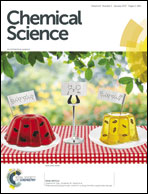Engineering catalytic coordination space in a chemically stable Ir-porphyrin MOF with a confinement effect inverting conventional Si–H insertion chemoselectivity†
Abstract
An iridium-porphyrin ligand, Ir(TCPP)Cl (TCPP = tetrakis(4-carboxyphenyl)porphyrin), has been utilized to react with HfCl4 to generate a stable Ir(III)-porphyrin metal–organic framework of the formula [(Hf6(μ3-O)8(OH)2(H2O)10)2(Ir(TCPP)Cl)3]·solvents (Ir-PMOF-1(Hf)), which possesses two types of open cavities (1.9 × 1.9 × 1.9 and 3.0 × 3.0 × 3.0 nm3) crosslinked through orthogonal channels (1.9 × 1.9 nm2) in three directions. The smaller cavity is surrounded by four catalytic Ir(TCPP)Cl walls to form a confined coordination space as a molecular nanoreactor, while the larger one facilitates reactant/product feeding and release. Therefore, the porous Ir-PMOF-1(Hf) can act as a multi-channel crystalline molecular flask to promote the carbenoid insertion reaction into Si–H bonds, featuring high chemoselectivity towards primary silanes among primary, secondary and tertiary silanes under heterogeneous conditions that are inaccessible by conventional homogeneous catalysts.



 Please wait while we load your content...
Please wait while we load your content...